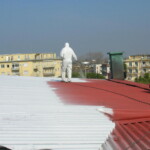
Asbestos encapsulation is a practice that aims to contain and seal off asbestos fibres present in materials such as gaskets, pipes, siding or roofing in order to prevent their dispersion into the air. The use of airless pumps for the application of encapsulation materials can be an effective choice, but it is important to strictly follow regulations and guidelines to ensure safety.
Here is a general guide to asbestos encapsulation with airless pumps:
Before Starting:
- Inspection and Evaluation:
- Conduct a thorough inspection to identify asbestos-containing areas requiring encapsulation.
- Assess the condition of the material and the need for removal or encapsulation.
- Risk Assessment:
- Assess the risks associated with the work, taking all necessary precautions and following safety regulations.
Surface Preparation:
- Cleaning and Removal of Contaminants:
- Clean the surface of any dust, dirt or contaminants.
- Remove paints or materials that could compromise the adhesion of the encapsulation material.
- Personal Protection:
- Wear appropriate personal protective equipment (PPE), such as overalls, masks, gloves and safety glasses.
Using the Airless Pump
- Selection of Encapsulation Material:
- Choose an approved encapsulation material specifically designed for use on asbestos. Please refer to the manufacturer’s specifications.
- Dilution (if necessary):
- Dilute the encapsulation material according to the manufacturer’s instructions, if necessary.
- Adjusting the Airless Pump:
- Adjust the airless pump according to the recommendations of the encapsulation material manufacturer. This can include pressure, nozzle size and application speed.
- Uniform application:
- Apply the encapsulation material evenly over the surface using the airless pump, avoiding build-up or overlooked areas.
After Application:
- Drying and Care:
- Allow the encapsulation material to dry completely according to the manufacturer’s instructions before exposing the surface to traffic or other weathering.
- Testing and Monitoring:
- Carry out tests to ensure the effectiveness of the encapsulation.
- Monitor the surface periodically to check the durability and integrity of the encapsulation material.
- Disposal of Residual Materials:
- Dispose of residual materials in accordance with local asbestos regulations.
It is essential that asbestos encapsulation is performed by qualified professionals and in accordance with local laws and regulations. The safety and health of operators and the environment are priorities in any work involving asbestos-containing materials.
Not to miss all our updates on the world of airless spraying click here!
